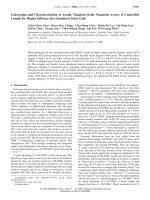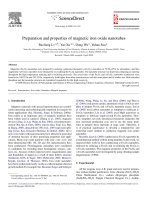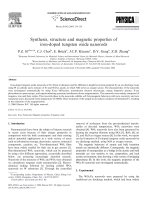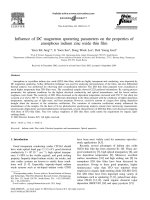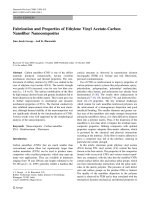Fabrication and properties of manganese doped zinc oxide
Bạn đang xem bản rút gọn của tài liệu. Xem và tải ngay bản đầy đủ của tài liệu tại đây (4.22 MB, 136 trang )
FABRICATION AND PROPERTIES OF MANGANESE
DOPED ZINC OXIDE
SU DAN
(B. ENG., BEIHANG UNIVERSITY)
A THESIS SUBMITTED
FOR THE DEGREE OF MASTER OF ENGINEERING
DEPARTMENT OF MATERIALS SCIENCE AND
ENGINEERING
NATIONAL UNIVERSITY OF SINGAPORE
2009
DEDICATION
to my father
SU XUEZHI
October 16, 1948-November 8, 2008
Acknowledgements
I would like to express my sincere gratitude to my supervisor, Professor John Wang
for providing the chance to experience studying in the research field and his invaluable
guidance and patience throughout the course of this work.
I also appreciate Miss Sim Chow Hong, Dr Wang Yang, Miss Zhang Yu, Dr Ye
Jiandong for sharing their knowledge and experiences in doing research. And special
thanks go to all the member of the Advanced Ceramics Lab Dr Li Baoshan, Mr Happy,
Miss Zheng Rongyan, Miss Fransiska, and Miss Serene Ng, and all the staff in the
Department of Materials Science and Engineering who in one way or the other, has
helped make my project an enjoyable and fruitful one. Especially I would like to give
my appreciation to Dr Hu Guangxia for his sincere help and assistance in the
measurement of photoluminescence.
Last but not least, I would like to express my appreciation to my parents for their kind
understanding and unconditional support.
I hereby declare that this thesis presents the results of my research work during the
period of my Master program and therefore take the full responsibility for its
authenticity.
I
Table of Contents
Table of Contents
Acknowledgements…………………………………………………………………..…I
Table of contents……………………………………………………………………....II
Summary ……………………………………………………………………………...V
List of Figures……………………………………………………………………….VII
List of Tables………………………………………………………………………...XII
CHAPTER 1 Introduction............................................................................................... 1
1.1
Zinc Oxide ................................................................................................. 2
1.1.1
The Structure of Zinc Oxide ............................................................... 2
1.1.2
The Properties of Zinc Oxide.............................................................. 5
1.1.3
Applications of Zinc Oxide................................................................. 7
1.1.4
Doping of Zinc Oxide ......................................................................... 9
1.2
ZnO-based Diluted Magnetic Semiconductors........................................ 12
1.3
References................................................................................................ 15
CHAPTER 2 Fabrication and Characterization Methods............................................. 18
2.1
2.2
Fabrication Methods ................................................................................ 19
2.1.1
Hydrothermal Method....................................................................... 19
2.1.2
Radio Frequency Magnetron Sputtering........................................... 21
Characterization Methods ........................................................................ 23
2.2.1
X-Ray Diffraction (XRD) ................................................................. 23
2.2.2
Atomic Force Microscopy (AFM) .................................................... 25
2.2.3
Scanning Electron Microscopy (SEM) ............................................. 26
II
Table of Contents
2.3
2.2.4
Photoluminescence ........................................................................... 28
2.2.5
Ultraviolet-Visible Absorption Spectroscopy ................................... 30
2.2.6
X-ray Photoelectron Spectroscopy ................................................... 32
References................................................................................................ 35
CHAPTER 3 Zn1-xMnxO Nanorods............................................................................ 37
3.1
Sample Preparation .................................................................................. 38
3.2
Morphology Study ................................................................................... 41
3.2.1
The Effect of Concentration of Reagents.......................................... 41
3.2.2
The Effect of Buffer Layers .............................................................. 44
3.3
Structure Investigation ............................................................................. 48
3.4
Optical Properties..................................................................................... 51
3.5
3.4.1
UV-Visible Absorption Measurement ............................................... 51
3.4.2
Photoluminescence ........................................................................... 54
References:............................................................................................... 77
CHAPTER 4 Zn1-xMnxO Thin Films.......................................................................... 80
4.1
Thin Film Preparation .............................................................................. 81
4.2
Structure Investigation ............................................................................. 83
4.3
4.2.1
XPS Measurements........................................................................... 83
4.2.2
XRD Investigation ............................................................................ 86
Morphology Study ................................................................................... 90
4.3.1
The Effect of Mn Doping Content .................................................... 90
4.3.2
The Effect of Partial Pressure of Oxygen ......................................... 92
III
Table of Contents
4.3.3
4.4
The Effect of Growth Temperature ................................................... 97
Optical Properties................................................................................... 105
4.4.1
Room Temperature Photoluminescence.......................................... 105
4.4.2
UV-Visible Absorption.................................................................... 108
4.5
Comparison of These Two Growth Methods ......................................... 113
4.6
References:............................................................................................. 115
CHAPTER 5 Conclusions & Future Work ................................................................. 118
5.1
Conclusions............................................................................................ 119
5.2
Future work............................................................................................ 121
IV
Summary
Summary
Manganese doped zinc oxide is a promising candidate for opto-electronic devices. In
this project, Zn1-xMnxO nanorods and thin films were fabricated by hydrothermal and
rf magnetron sputtering methods respectively. Zn1-xMnxO is expected to show
ferromagnetic and improved optical properties due to the incorporation of Mn. The
magnetic properties of Zn1-xMnxO derived from different routes have been studied, and
different magnetic behaviors have been reported. In this study, efforts were put into the
fabrication of the Zn1-xMnxO nanorods and thin films as well as their optical properties.
Hydrothermal growth and sputtering technique belong to chemical and physical routes
respectively. The former one is a quasi-equilibrium process while the latter one is of
non-equilibrium. The resultant structures and properties via these two routes are
studied and compared.
The growth conditions of both methods showed different effects on the morphologies
of Zn1-xMnxO structures. In the hydrothermal growth, the ZnO buffer layer grown
before the nanorods played an important role in controlling the density and diameters
of the nanorods, but the Mn concentration in ZnO did not change the hexagonal
morphology. However, in the sputtering, the Mn doping level, oxygen partial pressure,
and the growth temperature all had nontrivial influence on the morphology of the
deposited thin films, i.e. the grain size and the surface roughness. The XRD spectra for
the Zn1-xMnxO nanorods and thin films showed a peak shift, solidifying the fact that
manganese was successfully doped into the ZnO lattice.
V
Summary
UV-Visible (UV-Vis) absorption and photoluminescence (PL) measurements were
applied to study the optical properties of the nanorods and thin films. The low
temperature PL was also used to further understand the detailed optical properties for
hydrothermally grown nanorods. Some changes of the PL and UV-Vis absorption
spectra were observed due to the introduction of Mn into ZnO, consistent with the
structural characterization.
VI
List of Figures
List of Figures
Figure 1.1 Ball and stick representation of ZnO crystal structures: (a) cubic
rocksalt (B1), (b) cubic zinc blende (B3), (c) hexagonal wurtzite (B4). The
shade gray and black spheres denote Zn and O atoms, respectively .............. 3
Figure 1.2 A schematic diagram of the wurtzitic ZnO structure ........................... 4
Figure 2.1 A basic experimental set-up for RF sputtering machine..................... 22
Figure 2.2 A schematic diagram of the experimental geometry of X-ray
diffraction...................................................................................................... 24
Figure 2.3 A schematic diagram of an Atomic Force Microscope....................... 25
Figure 2.4 A schematic diagram of a scanning electron microscope................... 27
Figure 2.5 A schematic diagram of the processes occurring during
photoluminescence in a solid ........................................................................ 29
Figure 2.6 A basic experimental set-up for photoluminescence measurement.... 30
Figure 2.7 A schematic diagram of a UV-visible spectrometer .......................... 32
Figure 2.8 A schematic diagram of XPS processes ............................................. 33
Figure 2.9 A schematic diagram for a XPS system ............................................. 34
Figure 3.1 SEM images of Samples grown on Si substrates with 2min-sputteringdeposited buffer layers (a) Zn2+ 0.02M, Mn2+ 0.002M (b) Zn2+ 0.05M, Mn2+
0.005M (c) Zn2+ 0.08M, Mn2+ 0.008M (d) Zn2+ 0.1M, Mn2+ 0.01M (e) Zn2+
0.15M, Mn2+ 0.015M .................................................................................... 42
Figure 3.2 Relation between nanorods diameter and Zn2+ concentration (a) as
well as relation between nanorods length and Zn2+ concentration ............... 43
VII
List of Figures
Figure 3.3 SEM images for Zn1-xMnxO nanorods grown on 20sec (a), 40sec (b),
1min (c) and 2min (d) deposited buffer layers at 0.05M Zn2+ and 0.05M
HMTA concentration..................................................................................... 44
Figure 3.4 The dependence of nanorods density on the deposition time for buffer
layers ............................................................................................................. 45
Figure 3.5 A schematic diagram of the island growth mode (a) and the
corresponding nanorods growth (b) .............................................................. 47
Figure 3.6 Full range X-Ray diffraction patterns (a) and the fine scanned (002)
peak XRD patterns (b) for Zn1-xMnxO with different doping levels ............ 49
Figure 3.7 Variation of c-axis lattice constants with manganese concentration x 50
Figure 3.8 (a) UV-Vis absorption curves of Zn1-xMnxO (x = 0, 0.02, 0.05 and 0.1)
nanorods (b) Plot of (αhν)2 versus photon energy for Zn1-xMnxO nanorods at
different x values........................................................................................... 52
Figure 3.9 Variation of band gap with the percentage of Zn1-xMnxO nanorods... 54
Figure 3.10 Room temperature (296K) PL spectra for Zn0.98Mn0.02O nanorods (a),
and enlarged part at near-band-edge (NBE) region ...................................... 56
Figure 3.11 Illustration of the calculated defect energy levels in ZnO from
different literature sources ........................................................................... 57
Figure 3.12 Temperature dependence of the UV and defect emission for pure
ZnO nanorods (a), and enlarged part in the UV region (b) and visible
emission region (c)........................................................................................ 59
Figure 3.13 Temperature dependence of the UV and defect emission for
VIII
List of Figures
Zn0.98Mn0.02O nanorods (a), and enlarged part in the UV region (b) and
visible emission region (c) ............................................................................ 60
Figure 3.14 Temperature dependence of the UV emission (a) and visible emission
(b) for Zn0.98Mn0.02O nanorods ..................................................................... 61
Figure 3.15 Temperature dependence of the UV emission (a) and visible emission
(b) for Zn0.9Mn0.1O nanorods ........................................................................ 62
Figure 3.16 A schematic diagram of the electron capture process by an O vacancy
....................................................................................................................... 64
Figure 3.17 A schematic diagram of the Fermi-Dirac function .......................... 66
Figure 3.18 Temperature dependence of the PL intensities and the fitting results
(red solid lines) for pure ZnO (a), Zn0.98Mn0.02O (b), Zn0.95Mn0.05O (c),
Zn0.9Mn0.1O (d) nanorods respectively ......................................................... 70
Figure 3.19 The comparison of the NBE PL spectra for Zn0.98Mn0.02O,
Zn0.95Mn0.05O and Zn0.9Mn0.1O nanorods at different temperatures ............. 73
Figure 3.20 A schematic diagram of the band gap for undoped semiconductors (a)
and doped semiconductors (b) ..................................................................... 74
Figure 4.1 XPS spectrum of Mn 2p3/2 for Zn0.98Mn0.02O thin film on silicon at
600°C with Ar flow rate at 230 sccm and oxygen flow rate at 60 sccm,
respectively ................................................................................................... 84
Figure 4.2 XPS spectrum of Mn 2p3/2 for Zn0.9Mn0.1O thin film on silicon at
600°C with Ar flow rate at 230 sccm and oxygen flow rate at 60 sccm,
respectively ................................................................................................... 85
IX
List of Figures
Figure 4.3 X-ray diffraction results for different Zn1-xMnxO thin films grown on
Si substrates at 600°C with Ar and O2 flow rates at 230 sccm and 60 sccm
respectively (a) and the enlarged part of the (002) peak (b) ......................... 87
Figure 4.4 Variation of the c-axis lattice constant with the Mn concentration .... 89
Figure 4.5 The AFM images of different Zn1-xMnxO films grown on silicon
substrates with Ar and O2 flow rates at 230 and 60 sccm respectively and
deposition temperature at 600°C (a) Zn0.99Mn0.01O, (b) Zn0.98Mn0.02O, (c)
Zn0.96Mn0.04O, (d) Zn0.95Mn0.05O .................................................................. 91
Figure 4.6 Dependence of grain size (a) and roughness (b) on the Mn content in
Zn1-xMnxO thin films grown on silicon substrates with Ar and O2 flow rates
at 230 and 60 sccm respectively and deposition temperature at 600°C........ 92
Figure 4.7 Zn0.9Mn0.1O on sapphire substrate at different oxygen partial pressure
(a) O2 0 sccm (b) O2 20 sccm (c) O2 40 sccm (d) 60 sccm with Ar flow rate
at 230 sccm and growth temperature at 600°C ............................................. 94
Figure 4.8 Zn0.9Mn0.1O on glass substrate at different oxygen partial pressure (a)
O2 0 sccm (b) O2 20 sccm (c) O2 40 sccm (d) 60 sccm with Ar flow rate at
230 sccm and growth temperature at 600°C ................................................. 95
Figure 4.9 Zn0.9Mn0.1O on silicon wafer at different oxygen partial pressure (a)
O2 0 sccm (b) O2 20 sccm (c) O2 40 sccm (d) 60 sccm with Ar flow rate at
230 sccm and growth temperature at 600°C ................................................. 96
Figure 4.10 Dependence of grain size (a) and roughness (b) on the oxygen partial
pressure for Zn0.9Mn0.1O thin film deposited on different substrates with Ar
X
List of Figures
flow rate at 230 sccm and growth temperature at 600°C.............................. 96
Figure 4.11 Zn0.98Mn0.02O thin film on silicon substrate deposited at different
temperatures (a) 300°C (b) 400°C (c) 500°C (d) 600°C with Ar and O2 flow
rates at 230 and 60 sccm respectively........................................................... 98
Figure 4.12 Zn0.95Mn0.05O thin film on silicon substrate deposited at different
temperatures (a) 300°C (b) 400°C (c) 500°C (d) 600°C with Ar and O2 flow
rates at 230 and 60 sccm respectively........................................................... 99
Figure 4.13 Dependence of the grain size (a) and surface roughness (b) on the
growth temperature for films deposited on silicon substrate with Ar and O2
flow rates at 230 and 60 sccm respectively ................................................ 100
Figure 4.14 XRD patterns for Zn0.98Mn0.02O thin films deposited at different
temperatures on silicon substrate with Ar and O2 flow rates at 230 and 60
sccm respectively ........................................................................................ 101
Figure 4.15 The relation between the stresses of the Zn0.98Mn0.02O thin films and
the growth temperature ............................................................................... 103
Figure 4.16 Room temperature PL spectra for Zn1-xMnxO thin film at different
doping levels grown on silicon substrates at 600°C with the Ar and O2 flow
rates of 230 and 60 sccm respectively ........................................................ 106
Figure 4.17 UV-Visible absorption curves of Zn1-xMnxO (x = 0, 0.01, 0.02, 0.05
and 0.1) thin films on sapphire substrates with Ar and O2 flow rates at 230
and 60 sccm respectively at 600°C ............................................................. 109
Figure 4.18 Plot of (αhν)2 versus photon energy for Zn1-xMnxO thin films on
XI
List of Figures
sapphire substrates with Ar and O2 flow rates at 230 and 60 sccm
respectively at 600°C .................................................................................. 110
Figure 4.19 Variation of band gap with the percentage of Zn1-xMnxO thin films on
sapphire substrates with Ar and O2 flow rates at 230 and 60 sccm
respectively at 600°C .................................................................................. 110
XII
List of Tables
List of Tables
Table 4.1 Different atomic ratios of Mn and Zn in the prepared targets............... 81
Table 4.2 The fitting results of ZnO (002) peak for different films grown on Si
substrates at 600°C with Ar and O2 flow rates at 230 sccm and 60 sccm
respectively with various Mn contents ......................................................... 89
Table 4.3 The fitting results of ZnO (002) peak for Zn0.98Mn0.02O films deposited
at different temperatures on silicon substrate with Ar and O2 flow rates at
230 and 60 sccm respectively ..................................................................... 102
XII
CHAPTER 1
Introduction
CHAPTER 1
Introduction
1
CHAPTER 1
Introduction
1.1 Zinc Oxide
Zinc oxide (ZnO) has been discovered then widely studied since 1935 [1]. The
renewed interest is fueled by the availability of high-quality substrates and the
development of growth technologies for the fabrication of high quality single crystals
and epitaxial layers, allowing the realization of ZnO based electronic and
optoelectronic devices. Furthermore, the reports of ferromagnetic behavior when
doped with transitions metals also helped raise renewed interest.
With a wide bandgap of about 3.3 eV and a large exciton binding energy of 60 meV at
room temperature, ZnO is important for blue and ultra-violet optical devices [2]. Some
of these optoelectronic applications of ZnO overlap with those of GaN, another wide
band gap semiconductor (Eg = 3.4 eV at 300 K) which is currently widely used for
production of optoelectronics devices. However, ZnO has several advantages over
GaN, the most important being its larger exciton binding energy and the ability to be
grown on single crystal substrates. ZnO can also be grown via much simpler growth
technologies, leading to a much lowered cost for ZnO-based devices.
1.1.1 The Structure of Zinc Oxide
Most of the II-VI binary compound semiconductors crystallize in either cubic zincblende or hexagonal wurtzite structure, where each anion is surrounded by four cations
at the corner of a tetrahedron, and vice versa. This tetrahedral coordination is an
indicator of sp3 covalent bonding, but these materials also possess a substantial ionic
2
CHAPTER 1
Introduction
character. ZnO is an II-IV compound semiconductor whose ionicity lies at the
borderline between covalent and ionic semiconductor. There are three phases of ZnO,
i.e. wurtzite (B4), zinc blende (B3), and rocksalt (B1), as shown in Figure 1.1. At room
temperature and ambient pressure, crystalline ZnO is in the wurtzite structure. The
zinc-blende structure can be achieved only by growth on cubic substrates, and the
rocksalt structure may be prepared at relatively high temperatures.
Rocksalt (B1)
(a)
Zinc blende (B3)
Wurtzite (B4)
(b)
(c)
Figure 1.1 Ball and stick representation of ZnO crystal structures: (a) cubic rocksalt
(B1), (b) cubic zinc blende (B3), (c) hexagonal wurtzite (B4). The shade gray and
black spheres denote Zn and O atoms, respectively [2]
The wurtzite structure is a hexagonal lattice, which belongs to the space group P63mc,
and it has two lattice parameters, a and c, in the ratio of c/a = 8/3 =1.633 for an ideal
wurtzite crystal. A schematic representation of the wurtzitic ZnO structure is shown in
Figure 1.2. The structure comprises two interpenetrating hexagonal-close-packed (hcp)
3
CHAPTER 1
Introduction
sub lattices, each of which is composed of one type of atom displaced with respect to
each other along the threefold c-axis by the amount of u=3/8=0.375 (in an ideal
wurtzite structure) in fractional coordinates. The u parameter here is defined as the
length of the bond parallel to the c axis, in units of c. Each sub lattice comprises four
atoms per unit cell and every Zn atom is surrounded by four O atoms, or vice versa,
which are coordinated at the edges of a tetrahedron. In a real ZnO crystal, its structure
deviates from the ideal arrangement by changing the c/a ratio or the u value. For the
wurtzite ZnO, experimentally, the lattice constants at room temperature mostly range
from 3.2475 to 3.2501 Å for the a parameter and from 5.2042 to 5.2075 Å for the c
parameter [2, 18]. The real values of u and c/a were determined in the range u =
0.3817 to 0.3856 and c/a = 1.593 to 1.6035.
a
Zn
Zn
Zn
Zn
O
O
α
c
Zn
Zn
O
β
b 1'
Zn
O
b 3'
O
[0001]
O
b=u×c b '
2
O
Zn
Zn
Zn
Figure 1.2 A schematic diagram of the wurtzitic ZnO structure [2]
The lattice parameter deviation from the ideal structure is likely due to lattice stability
4
CHAPTER 1
Introduction
and ionicity. It has been reported that free charge is the dominant factor responsible for
expanding the lattice, which is proportional to the deformation potential of the
conduction band minimum and inversely proportional to the carrier density and bulk
modulus [10]. Besides, it is also influenced by point defects such as zinc interstitials,
oxygen vacancies, and extended defects, such as threading dislocations [11].
1.1.2 The Properties of Zinc Oxide
1.1.2.1 Electrical Properties
As a direct and large-band-gap material, ZnO has been attracting a lot of attention for
various electronic and optoelectronic applications. Advantages related with a large
band gap include high breakdown voltages, ability to sustain large electric fields, low
noise generation, and high-temperature and high-power operation. However, the
electrical properties of ZnO are difficult to quantify due to large variance of the quality
of samples available. The background carrier concentration varies greatly according to
the quality of the layers but is usually around 1016cm-3. The largest reported n-type
doping is around 1020 electrons/cm3, and the largest reported p-type doping is around
1019 holes/cm3. However, such high level of p-type doping is questionable and has not
been experimentally verified yet. The exciton binding energy is 60meV at 300K, and is
one of the reasons why ZnO is so promising for optoelectronic device applications.
The electron Hall mobility (μ) at 300K for low n-type conductivity is 200 cm2V-1s-1,
and for low p-type conductivity is 5-50 cm2V-1s-1.
5
CHAPTER 1
Introduction
However, the growth of stable p-type-conductivity ZnO crystals remains a problem
currently, which will potentially impact the applications of ZnO into the world of
optoelectronic devices. In spite of the progress that has been made and the reports of ptype conductivity in ZnO using various growth methods and various group-V dopant
elements, a reliable and reproducible high quality p-type has not been achieved for
ZnO. Because ZnO with a wurtzite structure is naturally an n-type semiconductor due
to a deviation from stoichiometry in the presence of intrinsic defects such as O
vacancies (Vo) and Zn interstitials (Zni), p-type dopants can be compensated by these
low-energy native defects.
1.1.2.2 Optical Properties
Zinc Oxide is transparent to light in the visible region with a sharp cut-off in the UV
region. This region corresponds to the wavelength region from 0.3-2.5μm [5]. This
indicates that it is transparent to visible light but absorbs ultra-violet light. The typical
optical transmittance deposited under optimum conditions is 90% [4]. This feature and
a refractive index of 2.0 allow ZnO to be used as a white pigment in the paint industry
[3]. Zinc Oxide can be doped with other elements to improve its electrical and optical
properties. Dopants that have been studied for their effects on the optical properties of
ZnO include Al, In, Mn, and Pb. In general, doping with different donors produces
broadening of the UV emission peak, but the peak shift is dependent on the dopant [4].
Since both un-doped and doped ZnO can exhibit different optical properties dependent
on the fabrication conditions, it is difficult to establish how the properties will change
6
CHAPTER 1
Introduction
after doping. New emission peaks may be observed when synthesis condition is
modified; most importantly, a red shift of the near band-edge emission is expected
when the carrier density significantly increases. Mn doping was found to quench green
emission [6], although other studies reported reduction in both UV and defect emission
[7]. Very similar spectra of ZnO and Mn-implanted ZnO were observed after
annealing an implanted sample at 800ºC [8]. A similar UV-to-green emission ratio has
been observed in un-doped and Mn-doped ZnO [9]. Obviously, the change in the
optical properties is strongly dependent on the method of incorporation of Mn,
fabrication conditions, and properties of un-doped ZnO fabricated under similar
conditions.
1.1.3 Applications of Zinc Oxide
High quality bulk and epitaxial ZnO thin films as well as ZnO nanostructures have
been synthesized by various methods. This opens the door to the fabrication of novel
devices for the use in optoelectronics and nano-electronics, such as sensors, detectors
and switches [10].
One of the devices with the greatest potential for commercial impact is a light emitting
diode (LED) in the UV region. The production of thin-film-based UV LEDs has
already been successful [11]. An example is the report from Ryu et al.[14] of the
fabrication of a ultraviolet laser diode based on layered ZnO/BeZnO films, which were
pressed to form a multiple quantum well (MQW). The n-type layers were Ga-doped
ZnO/BeZnO films and As-doped ZnO/BeZnO films as p-type layers. More recently,
7
CHAPTER 1
Introduction
the same group also demonstrated the fabrication of a ZnO UV/visible LED [13] by
combining a UV LED with phosphors to produce light covering the whole visible
color spectrum.
p-type ZnO nanowires have been possible [12]. This p-type doping, together with the
growth of vertical arrays of nanowires, enables the fabrication of LEDs with a large
junction area, which in turn translates to higher efficiency. Lasers based on the
cylindrical geometry nanowires could also serve as high-efficiency light sources for
optical data storage and imaging.
A ZnO based field effect transistor (FET) has been made using single nanobelts [15,
16]. The principle of this device is that adjusting the gate voltage would control the
current flowing from the source to the drain. The production of these FETs using
nanobelts has allowed the exploration of physical and chemical properties of the
nanostructures. Arnold et al. [17] has demonstrated the fabrication of nanoscale FETs
using SnO2 and ZnO nanobelts as the FET channels.
ZnO also presents suitable characteristics in the development of gas sensing devices
(metal oxide sensors, NO2, CO, H2, NH3) [11]. A recent report is the fabrication of a
low-temperature hydrogen sensor based on Au nanoclusters and ZnO films [18].
Moreover, Moreira et al. have shown with numerical calculations and experiments the
good sensitivity of ZnO to the mass loading effect through a high electromechanical
coupling coefficient and temperature compensation [19]. Because ZnO is a bio-safe
and biocompatible material, it can be used for biomedical applications. Nanosensors
8
CHAPTER 1
Introduction
based on nanobelts have the potential for implantation in biological systems and may
be unique in detecting single cancer cells and measuring pressure in a biological fluid
[12].
Finally, the piezoelectricity of ZnO leads to the fabrication of vibrational sensors and
nanoresonators which can be used to control the tip movement in scanning probe
microscopy; nanogenerators, which can be used in the construction of wireless sensors,
implantable biomedical devices and portable electronics. Wang and Song [20] have
demonstrated an approach to converting mechanical energy into electric power using
aligned ZnO nanowires. These piezo-based nanogenerators have the potential of
converting mechanical, vibrational, or hydraulic energy into electricity for powering of
nanodevices.
1.1.4 Doping of Zinc Oxide
One of the big challenges in ZnO research is the doping of impurities. ZnO occurs
naturally as n-type with reported concentrations from ~1016 to 1018cm−3 in typical
high-quality material [15]. The origin of the n-type conductivity is controversial in
both theoretical and experimental studies. From photoluminescence and annealing
experiments, Look et al. [15] have concluded that group-III elements (Al and Ga) are
the most prevalent donors in ZnO. Hydrogen can also be present and is believed to be
a shallower donor. Van de Walle [16] also assigned H as one of the principal
candidates for the n-type dopant based on first principles, density-functional
calculations. Walle [16] showed that the hydrogen occurs exclusively in the positive
9
CHAPTER 1
Introduction
charge state, thus, it always acts as a donor in ZnO. Native defects (O vacancies and
Zn interstitials) have also been suggested as possible n-type dopants.
Zhang [17], by theoretical calculations, showed n-type doping due to zinc interstitials.
As in a shallow level, the zinc interstitial supplies electrons; the low formation energy
of this defect allows it to be abundant as well. Conversely, native defects that could
compensate the n-type doping have high formations energies under zinc-rich growth
conditions so the presence of “electron killers” would be rare. The oxygen vacancy
(VO) has been found to be a deep donor [15, 17], and it is unlikely to be responsible for
free-electrons concentrations of the order of 1017 cm−3 or higher.
Different levels of n-type doping and p-type doping have proven extremely difficult to
produce due to stability issues and compensation by low-energy native defects. Most
of the attempts to produce p-type ZnO have employed N as the acceptor. Nitrogen is a
natural choice for an acceptor dopant since it has about the same ionic radius as that of
O, and thus it can be placed in a substitutional oxygen site [15]. The effort to produce
p-type ZnO can also be affected by the presence of H, being a donor in ZnO by
compensating the acceptors [18]. In addition to N0 (Nitrogen on an oxygen site), other
possible candidates for acceptors are P0 (Phosphorus on an oxygen site) and As0
(Arsenic on an oxygen site) and other group-V elements. Production of p-type ZnO
using P and As has been experimentally successful [8]. Finally, from the group I
elements, Li, Na, K on Zn sites are also candidates for p-type doping. One of the
important observations is that of a p-type ZnO thin film by using two acceptors, Li and
10
